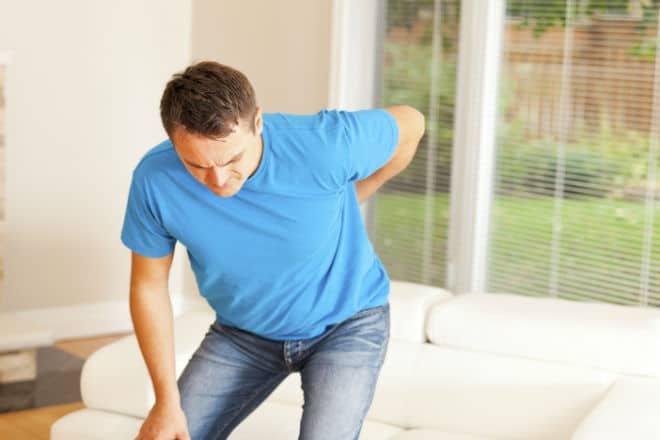
Disc injuries are a common presentation for Chiropractors They go hand in hand with increases in the amount of time people sit (at home and the office), weak abdominal strength and poor low back stability. The increased flexion of our low back that results from sitting compromises disc tissue and leaves us more susceptible to a disc injury. Further, disc injuries are more common when performing bending & rotating movements, especially when lifting heavy loads. At Springwood Chiropractic we keep up to date in the latest research and most effective treatment options for the management of disc injuries. A recent study published in the highly respected Annals of Internal Medicine showed that patients who had back related leg pain who had combined chiropractic care had better outcomes. The group who had combined spinal manipulation therapy (SMT), with home exercise and advice (HEA) had better results than those who had at home exercise only. The chiropractic care plus home exercise and advice group also sustained better secondary outcomes in terms of patient global improvement, satisfaction and reduced need for medication use.1
Surgery should only be considered for a slipped disc after a trial of conservative care.
At Springwood Chiropractic our conservative care involves specific spinal manipulative techniques, muscle therapies and spinal mobility protocols. These clinically proven therapies are aimed at reducing the degree and inflammation associated with a disc injury.
Flexion distraction and traction technology are a further addition at Springwood Chiropractic. Traction treatment was found to be an effective treatment in enhancing nutritional supply and promoting disc cell proliferation of the degraded discs.2-5
These same findings were shown in an American federally funded study of the lumbar spine biomechanics when the spine is treated with flexion distraction and decompression spinal manipulation.
Results showed increased disc height, drops in intradiscal pressure, a 28% increase in foraminal area, and physiological range of motion attainment of the facet joint complex.6-12
 At Springwood Chiropractic a thorough history, spinal, orthopaedic and neurological examination will be conducted. Special diagnostic imaging investigations such as x-ray, CT scan or MRI scans may also be required for accurate diagnosis. An individualised, and evidence based treatment plan will then be explained. Treatments are safe, effective and address underlying musculoskeletal imbalances.
At Springwood Chiropractic a thorough history, spinal, orthopaedic and neurological examination will be conducted. Special diagnostic imaging investigations such as x-ray, CT scan or MRI scans may also be required for accurate diagnosis. An individualised, and evidence based treatment plan will then be explained. Treatments are safe, effective and address underlying musculoskeletal imbalances.
Further to your acute treatment, we focus on the long term prevention of repeated disc injuries with a tailored rehabilitation program. Rehabilitation enhances stability, strength and posture, ensuring the best outcomes for the long term.
Before considering surgery or any other forms of treatment place yourself in the best hands at Springwood Chiropractic. We can help you. Simply call or book online us to begin your care today.
References
1. Gert Bronfort, et al., Spinal Manipulation and Home Exercise With Advice for Subacute and Chronic Back-Related Leg Pain: A Trial With Adaptive Allocation. Ann Intern Med., 2014. 161(6): p. 381-391.
2. Kuo YW, et al. Spinal Traction promotes molecular transportation in a simulated degenerative intervertebral disc model. Spine 2014 Feb 12
3. Guehring T, Omlor G, Lorenz H, Engelleiter IK, Richter W, Carstens C, Kroeber M, Disc distraction shows evidence or regenerative potential in degenerated intervertebral discs as evaluated by protein expression, magnetic resonance imaging, and messenger ribonucleic acid expression analysis. Spine 2006:31(15):1658-65
4. Hee HT, Zhang JT, Wong HK. Effect of cyclic dynamic tensile strain on previously compressed annular fibrosus and nucleus pulposus cells of human intervertebral disc – a vitro study. Journal of Orthopedic Research 28(4). Apr 2010:503-9
5. Hee HT, Chuah YJ, Tan BHM, Setiobudi T, Wong HK. Vascularization and morphological changes of the endplate after axial compression and distraction of the intervertebral disc. Spine 2011.36(7):505-11
6. Gudavalli MR, cox JM, Baker JA, Cramer GD, Patwardhan AG. Invertebral disc pressure changes during the flexion distraction procedures for lower back pain. Presented at and in the proceedings of the International Society for the Study of the Lumbar Spine Meeting, June 1997, Singapore.
7. Gudavalli MR. Estimation of dimensional changes in the Lumbar intervertebral foramen of the lumbar spine during flexion distraction procedure. Proceedings of the 1994 International Conference on Spinal Manipulation. June 10-11, 1994, Palm Springs, CA, p81
8. Gudavalli MR, cox JM, Baker JA, Cramer GD, Patwardhan AG. Invertebral disc pressure changes during a Chiropractic Procedure. Presentation and publication at the ASME IMECE 97 Bioengineering Convention, November 16-21, 1997, Dallas, Texas. Advances in Bioengineering 1999:BED, vol. 39, p187-188
9. Gudavalli MR, cox JM, Baker JA, Cramer GD, Patwardhan AG. Invertebral disc pressure changes during a Chiropractic Procedure. Abstract from the proceedings of the Bioengineering Conference, Phoenix, 1999
10. Bulbulian R, Dishman JD, Burke J. Neuroreflex modulation of the lumbar spine in flexion and distraction. New York Chiropractic College, Seneca Falls, New York `13148. Presented at the 5th World Federation of Chiropractic in Auckland, New Zealand. May 15-23, 1999
11. Bulbulian R, Burke J, Dishman JD. Spinal reflex excitability changes after lumbar spine passive flexion mobilization. Journal of Manipulative and Physiological Therapies
2002;25(8):526-53
12. Gudavalli MR, Potluri T, Carandang G, et al… Intradiscal Pressure Changes during manual Cervical Distraction: A Cadaveric Study, Evidence-Based Complementary and Alternative Medicine, vol. 2013 Article ID954134, 2013
